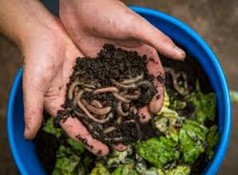Getting Started – How to Compost
- 2023-03-05
- By mkirk
- Posted in Horticulture, The Garden Buzz
By Judy Kunz, Colorado Master Gardener
The benefits of incorporating compost into almost any soil on an annual basis are substantial. Compost adds organic matter that helps retain moisture and nutrients in sandy soils, adds oxygen by breaking up tightly packed soil particles in clay soils, and introduces beneficial microorganisms that enhance deeper roots, overall plant growth and soil health. In addition, some studies have demonstrated that compost may indirectly suppress plant diseases by promoting soil health and, therefore, plant vigor.

Compost can be added to the soil or can also be used as a top dressing in gardens, not only to enhance the appearance of a garden, but also to help plants retain moisture. In addition, when mixed in a ratio of 1/3 compost to 2/3 potting soil, it can be used as a potting medium, thereby improving the health of potted plants.
The four necessary components of compost are: carbon, nitrogen, oxygen and water. Compost is prepared by managing the decomposition of organic materials like yard waste (grass, leaves and small twigs up to ¼”in diameter), kitchen vegetable and fruit scraps, un-coated paper, manure, straw and hay. Manures should be used with caution, however, if compost is planned for a vegetable garden. If they are not completely decomposed, they may harbor undesirable bacteria.

Basic compost structures can be as simple or complex as desired. They range from a simple heap or pile, a wood pallet or snow fence structure, wire structure, or a purchased composter, available online or at garden centers and big box stores. While an open compost pile is an easy, no-cost way to get started, it does tend to attract local wildlife. Worm composting is also gaining popularity as a sustainable method of creating compost. Red wiggler worms are available online or at local garden centers.
For success, start simple in a “learn as you go” approach. The optimal place for compost is in an easily accessible location that is exposed to a mix of part sun and shade. Cut up or shred material going into the mix to speed up decomposition. Alternate layers of green and brown materials in a ratio of 2/3 green to 1/3 brown. Turn the material with a pitchfork often to oxygenate contents. Add moisture as needed to maintain the consistency of a damp, wrung-out sponge. The importance of turning and keeping the ingredients moist can’t be overstated. In the dry Front Range climate, materials won’t break down readily without the proper moisture and oxygen content. Finished compost should be dark brown and crumbly with no recognizable components and only a pleasant, earthy odor.
When adding compost to the garden in the spring, it is advisable to remember that 5-7% organic matter is an ideal amount. This can be achieved by covering the garden surface with several inches of compost and working it into the soil. It is important to avoid adding excessive amounts of compost because over-amending can interfere with plant nutrient uptake.
Investing the time and effort to add composted organic matter to the garden each year will not only contribute to a more sustainable environment, it will also pay off in the form of healthier, more productive plants.
For links to detailed information on materials to use in composting and constructing a compost bin see: https://arapahoe.extension.colostate.edu/2023/01/05/sustainability-begins-at-the-compost-pile/
Horticulture Resources
- Garden Buzz Archives
- CSU Extension Resources
- Colorado Master Gardener Program
- Foothills to Plains Native Plant Master Program
- Native Bee Watch Community Science Program
- The Co-Hort Blog
- PlantTalk Colorado
- Soil Testing
- Plant Select
- Emerald Ash Borer
- Japanese Beetle
- Colorado State Forest Service
- Ask an Expert


